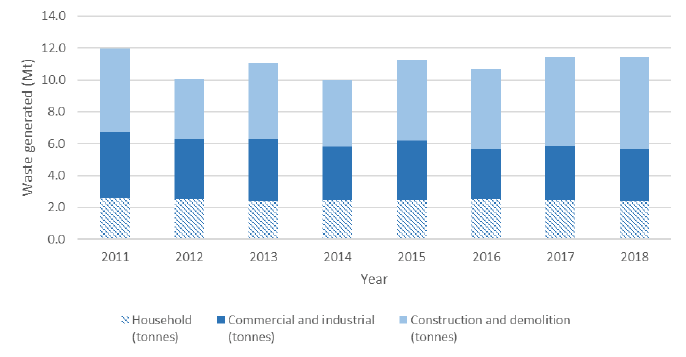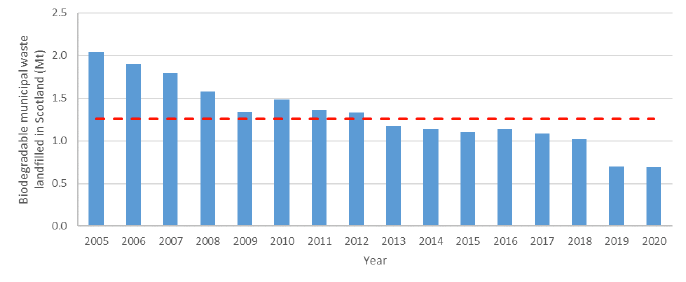Role of incineration in the waste hierarchy - review: call for evidence
The call for evidence seeks your views and evidence relating to the review of the role of incineration in the waste hierarchy.
4. Policy landscape and background to waste management in Scotland
Targets and ambitions
The Scottish Government has set out a range of waste reduction and recycling targets[2]. By 2025, Scotland aims to:
- reduce total waste arising in Scotland by 15% against 2011 levels
- reduce food waste by 33% against 2013 levels
- recycle 70% of the remaining waste
- send no more than 5% of remaining waste to landfill
- end the practice of landfilling biodegradable municipal waste (BMW) in Scotland by 2025.
In addition, the Scottish Government has agreed to extend the ban on landfilling BMW to include biodegradable non-municipal waste, subject to appropriate consultation and work to provide assurance around some specific waste streams[3].
The Climate Change Plan3 sets out an ambition to reduce greenhouse gas emissions from the waste sector (excluding emissions from incineration for energy from waste) from around 1.9 million tonnes of carbon dioxide equivalent (MtCO2e) to 1.2MtCO2e per year by 2025, and to 0.8 MtCO2e per year by 2030.
Where is Scotland now?
Waste Arisings
The latest official statistics that are available[4] suggest that around 11.45 Mt of waste were generated in Scotland in 2018. Of this, 2.4 Mt is household (HH) and 3.2 Mt is commercial and industrial (C&I) wastes, with most of the rest being construction & demolition (C&D) waste. This is a reduction of 4.2% since 2011 (Figure 1). While there has been a general reduction in HH (7% between 2011 and 2018) and C&I waste (22% between 2011 and 2018), the amount of C&D waste generated fluctuates year on year, but has recently risen in line with economic activity.

Recycling
In 2018, Scotland recycled 60.7% of waste from all sources, around 7.07 Mt of the waste produced. This was an increase of 1.1 percentage points from the 59.6% recycled in 2017[5]. For 2020, the HH waste recycling rate was 42.0% a decrease of 2.9 percentage points from the 44.9% rate achieved in 2019[6].
Landfill: All Waste
The total amount of waste disposed of to landfill has generally decreased steadily since 2007. In 2020, Scotland sent 2.6 Mt to landfill, a reduction of 390,000 tonnes (13%) from 2019 and a reduction of over 4.4 Mt (63%) from 2005[7]. There was a modest (2.8%, 21,000 tonnes) reduction in HH and similar wastes landfilled in 2020 compared with 2019, partly due to a decrease in the amount of this waste material category available for disposal and partly due to a change in the management of these wastes over the last few years.
Landfill: Biodegradable Municipal Waste[8]
The amount of biodegradable municipal waste (BMW) disposed of in landfill has also followed a decreasing trend (Figure 2). In 2020, the amount of BMW disposed to landfill was 691,000 tonnes. This is a reduction of 8,000 tonnes (1.1%) from 2019 and 1.3 Mt from 2005, exceeding the EU target to landfill less than 1.26 Mt BMW by 2020.

Incineration
The total quantity of waste incinerated in Scotland in 2020 was 1.26 Mt, an increase of 0.38 Mt (3.1%) from 2019, consistent with the longer term trend of an increase of 0.86 Mt (208%) from 2011. There was a 6.0% (20,000 tonnes) increase of HH and similar wastes incinerated in 2020. At least one municipal incineration site has reported an increase in these wastes being due to an increase in municipal waste arising from the COVID-19 pandemic.
Carbon emissions
Carbon emissions from waste management (excluding from incineration) declined significantly from 6.1 MtCO2e per year in 1995 to 1.4 MtCO2e per year in 2013, and have remained relatively stable in recent years, with a value of 1.5 MtCO2e in 2019.
The carbon impact[9] of HH waste in 2020 was 5.8 MtCO2e, an increase of 179 ktCO2e (3.2%) from 2019, and a reduction of 0.92 MtCO2e from 2011[10].
Contact
Email: incineration-review@gov.scot
There is a problem
Thanks for your feedback